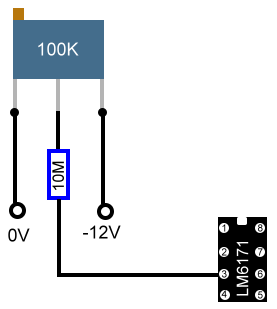Hi
Mike, I'm glad to hear your dental health is good again… some of your recent posts seemed horror tales. I wish you new fun moments playing with op-amps, caps, resistors, trimmers and a soldering iron and enjoying music…
Regarding the debate on the capacitors in WNA amp, I’d like to post my opinion. I must admit that my electronic knowledge is very basic, and this post is based mostly in ideas picked from this and other forums, my listening impressions and (I think) a little common sense.
The sound of the LM6171 op-amp is truly special and I’d like to keep it. The WNA hp amp is optimised around it and there is an unanimity about its fast and transparent sound, if properly implemented, that I’ve not found about other op-amps (not even the OP627 or AD843). However, according to several posts in this forum, it has a weird behaviour in dc offset (Mike has even measured it). With other op-amps there is no need to prevent it perhaps because they seem inherently “dc offset-proof” (which the LM6171
is not). Therefore, it is possible that the LM6171 generates
itself a dc offset at its output, that amplified by the following stages in the amplifier can be dangerous to the headphones connected to the amp, even damaging them.
The resistor-and-trimpot solution is good but it is complicated to implement (it needs careful and individual measuring and adjustment) and perhaps changes in temperature or any abnormal situation can drift the dc value for what it is adjusted, making it nearly useless.
An
output capacitor in series is the bullet-proof solution and a good sounding one, assuming the cap is high quality (to avoid a loss of transparency or a mushy sound) and high value (to avoid phase shifts and an impaired bass response). I hope the Black Gate bipolar Nx 1000uF/25V I use is up to this task. In any case, a small loss of quality (if it does exist) would be compensated by the peace of mind of knowing that under
no circumstances my beloved (and expensive) Grado HP-2 headphones can be destroyed by dc amplified by the WNA amp, simply because this would have been blocked by the output caps before reaching the outside world.
However, I’m going to keep the
input caps out. Without them, the amp sounds better than ever and I assume it is safe not to use them, as the majority of sources have no problems of excessive dc offset and many have their own output caps, making the input caps in the WNA redundant (I’ve measured various CD and DVD players, with readings from 0 to 1-3 mV). And, even if
all goes wrong and, for whatever reason, a burst of dc coming from the source goes into the "input cap-less" WNA amp and damages any of their components, their repair would be a lot easier and cheaper than doing so with a pair of expensive headphones or (if I use the WNA as a preamp in a future) a power amplifier and a pair of loudspeakers, because these all were protected by the output caps in the WNA amp. Remember that the modest cost of Dr. White’s little amp is far below its great musical performance.
BTW, I have a question to Udo and Mike, regarding the crackling noise when I turn the volume all the way down. Using an insulating glove or touching one of the rear screws of the pot with a wire connected to ground has no effect. Is it dangerous to my headphones or whatever is connected to the output of WNA amp or simply is it a small nuisance?. I assume that with output caps it is
impossible for dc offset to find its way outside the WNA amp. I’ve read in the HeadRoom webpage that in their AirHead hp amp (which I have, as my portable, battery-powered amp) they use output caps, but not caps around the volume control, in order to get the best sound quality, although the price to pay is a small noise when turning up or down the volume, similar to that I have in my “input cap-less” WNA amp. If this crackling is not dangerous, perhaps I don’t even bother to fix it
.
Regards
Jose
PS.: Udo, the PSU you have built is impressive and I’m looking forward to hear your listening impressions, as I’m sure that the power supply is a very important factor if one searches truly the ultimate sound quality. I have a WNA cascode PSU connected to my WNA hp amp with great sonic results, but I’m a little confused about the different wiring options and I need a bit of help and advice… but I’ll left that for another post…












